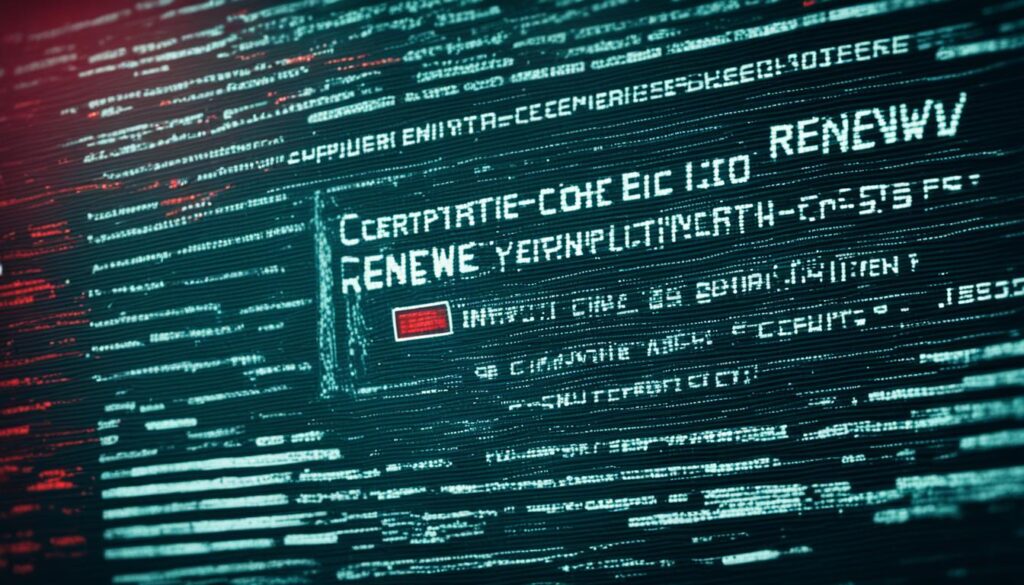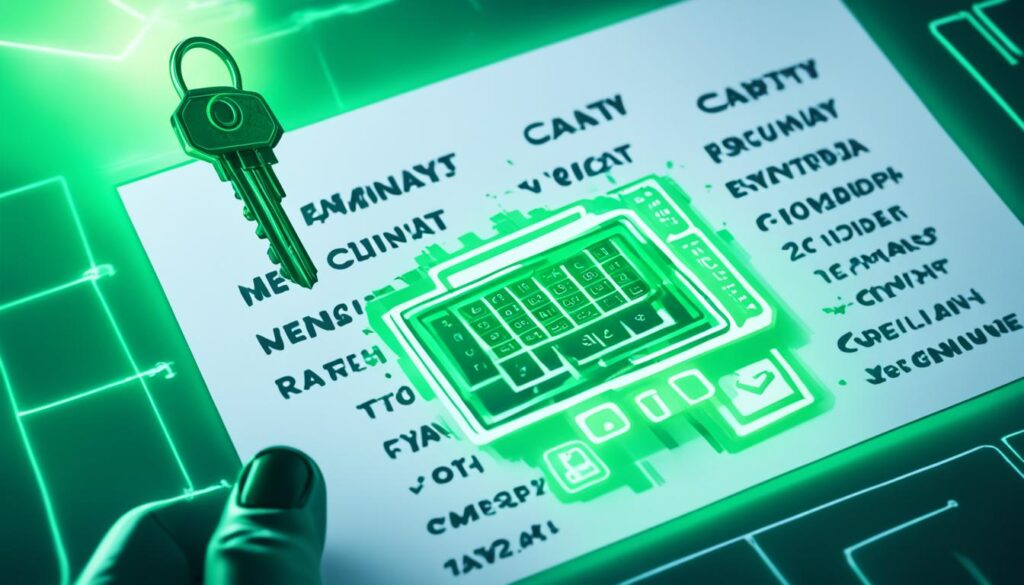In the realm of digital security, a staggering 70% of users reportedly hesitate to download software if they encounter a security warning—a statistic that highlights the importance of a renew code signing certificate process. For software developers, renewing code signing certificates is pivotal to sustaining user trust and confirming software authenticity. With the industry constantly evolving, developers must navigate through new compliance measures, such as the requirement for private key storage on certified hardware and updated organizational validations, ensuring a seamless and secure update code signing certificate procedure.
As software creators strive for excellence, an expired certificate can spell disaster, leading to a tarnished reputation and compromised user trust. Therefore, understanding the intricate steps for renewal, including aligning with new standards, is absolutely crucial. Let’s delve into best practices and step-by-step processes to make your certificate renewal as smooth as silk.
Key Takeaways
- Ensuring certificate renewal is crucial to avoid download hesitation caused by security warnings.
- Adapting to new industry standards is a must for any certificate renewal strategy.
- Staying updated with the latest compliance measures safeguards software integrity.
- A proactive approach to renewing code signing certificates enhances user trust and developer credibility.
- Understanding the renewal process can prevent the potential fallout associated with expired certificates.
- Timely renewal is key to continuous software distribution without interruptions.
Understanding the Importance of Code Signing Certificate Renewal
The integrity of any software is intrinsically linked to the authenticity that a code signing certificate provides. Recognized by operating systems and browsers alike, these certificates are fundamental to ensuring that users can trust the source of their downloaded software. Thus, the process of code signing certificate renewal is not just a mere formality; it is a crucial step to maintain the software’s validity and prevent alarming security warnings that could undermine a user’s confidence.
To help grasp the full gravity of renewing code signing certificates, consider the implications of letting these credentials lapse. In the absence of a valid certificate, your software could quickly be labeled as potentially malicious, leading users to second-guess their decision to install it, let alone download it. Therefore, the renewal is not merely a technical procedure but a pledge of software reliability and developer reputation.
- The proactive renewal of code signing certificates substantiates continuous trust by consumers.
- Avoidance of security error prompts that can drastically affect software adoption rates.
- Reaffirmation of the developer’s credibility by preserving identity validation.
Renewing your code signing certificate before it expires is tantamount to maintaining a security seal of approval for your software.
As the landscape of digital security evolves, so does the importance of keeping certificates updated. With cybersecurity threats on the rise, developers who prioritize code signing certificate validity stand out by showcasing a commitment to the protection of the end-user’s digital environment.

| Aspect of Renewal | Benefits | Consequences of Neglect |
|---|---|---|
| Timeliness | Seamless continuation of trust | Potential interruption in software distribution |
| Validation | Confirms the authenticity of the publisher | Erosion of user confidence and software integrity |
| Reputation | Consistent developer identity assurance | Risks security warnings deterring downloads |
Ultimately, by understanding and implementing timely code signing certificate renewal practices, developers ensure that their software continues to be received as trustworthy and secure by users, thereby upholding the software distribution’s overall health. This proactive measure is an indispensable part of the software’s lifecycle management that engenders continuous confidence in its security and functionality.
Consequences of Letting Your Code Signing Certificate Expire
The lapse of a code signing certificate expiration date carries with it a cascade of detrimental effects for software developers and their users. Foremost, it strikes at the heart of a software’s perceived integrity and legitimacy. Let’s examine some of these outcomes:

When a code signing certificate approaches its expiration, warning signs begin to manifest within the user’s experience. Microsoft SmartScreen warnings might start to appear, casting doubt on the reliability of the software. From the development and distribution standpoint, these warning signals are akin to an amplifying megaphone broadcasting concerns about the security of the software to current and potential users. This is often all it takes for a user to hesitate and decide not to proceed with the software installation, thus impacting software adoption and developer credibility.
“An expired certificate can lead to a chain reaction of decreased user trust, which then snowballs into diminished software distribution and ultimately, a loss in developer revenue.”
The timing of a certificate expiration plays a critical role. In the interim between the certificate’s expiration and the acquisition of a new one, developers are faced with a void—a period during which newly developed software cannot be signed. This gap can be devastating as it halts the ability to distribute software updates or new products, directly impacting the service flow to customers and the software’s market presence.
- Users see ‘unknown publisher’ alerts instead of the trusted developer’s name
- SmartScreen warnings deter users from downloading and installing software
- Potential revenue and reputation loss for developers
- Untimely gaps in software distribution can further exacerbate trust issues
To mitigate these consequences, it is crucial for software publishers to have robust certificate management protocols and to initiate the renewal process well in advance of the expiration date. By ensuring certificates are renewed on time, software publishers can maintain uninterrupted trust and security for their user base.
Renewing Code Signing Certificates: Essential Preparatory Steps
When the time comes to renew a code signing certificate, software developers are required to undertake a series of essential preparatory actions. This preliminary phase is pivotal for ensuring that the renew code signing certificate process adheres to code signing best practices and maintains strong code signing certificate management throughout its lifecycle. These preparatory steps are not just bureaucratic necessities, but they are foundational in continuing to foster trust and integrity within users’ digital experiences.

New Key Pair Generation for Enhanced Security
Starting with security at the forefront, generating a new key pair is a definitive step towards enhancing the protection of your software’s digital signature. By renewing your certificate with fresh cryptographic keys, you minimize the potential for compromise that might exist if original keys were ever imperiled. This is especially true when dealing with Extended Validation (EV) code signing certificates, as they necessitate hardware security module (HSM) integration or when transitioning to a new certificate authority (CA).
Validation Requirements for Renewal
The renewal process invariably involves validating the authenticity of the developer or organization behind the software. If the renewal is performed with the original CA, this process may be expedited; however, it remains a non-negotiable component of the process. For standard code signing certificates, domain validation is crucial, ensuring the email address employed in the process is associated with a domain that has been previously validated and deemed trustworthy.
A Step-by-Step Guide to Renew Code Signing Certificates
If you’re a software developer or publisher, understanding how to renew your code signing certificate is paramount to maintain the security and integrity of your applications. The renew code signing certificate process involves several key steps, which must be approached systematically to ensure efficient renewal and minimal downtime. Below is a comprehensive guide on the steps required to renew your certificate.

Purchasing the Service: Begin by selecting and purchasing a code signing certificate renewal service from your Certificate Authority (CA). If you use the same CA as before, the process might be expedited.
Generating a New CSR: Generate a new Certificate Signing Request (CSR) if there are changes in your security or if you’re required to update platform details. This is critical for authentication purposes.
Validation: Undergo the validation process once more to verify the legitimacy of your organization. This step is important to maintain trust with platforms and end-users.
Installation: Once approved, install the renewed certificate on your system. Proper installation is crucial for your applications to be recognized as safe and trusted.
Each step in the renewal process plays an essential role in ensuring that your applications remain secure and your users remain confident in using your software. Therefore, adhering to these prescribed practices is crucial for a smooth and problem-free certificate renewal.
| Step | Action Required | Outcome |
|---|---|---|
| 1. Purchase Service | Select and pay for a renewal with your CA. | Renewal process initiated. |
| 2. Generate CSR | Create a new CSR for updated security or platform changes. | Valid CSR ready for submission to CA. |
| 3. Validation | Complete the organization validation process again. | Verified legitimacy of the organization. |
| 4. Installation | Install the new certificate on your development system. | Ready to sign applications with a renewed and valid certificate. |
Remember that certificate renewal is not just a technical formality; it underpins your software’s credibility. By following this guide, you can effectively manage and execute the renewal of your code signing certificate, ensuring continuous trust in your software distribution.
Adhering to New Industry Standards for Code Signing
Code signing best practices are not only a matter of procedure, but a necessity in the rapidly evolving landscape of software security. As industry standards evolve, so must the strategies for code signing certificate management. These best practices are essential for the assurance of a robust security infrastructure, protecting both developers and end-users from potential vulnerabilities.

For instance, the industry now recommends the adoption of RSA 3072-bit keys or larger. This increase in key size is not a mere upgrade in numbers; it represents a significant leap in security, making the encryption process much tougher to compromise. Additionally, organizations must undergo rigorous validations to ensure they are approved for either standard or EV (Extended Validation) code signing. The distinction between these two is vital as they cater to different levels of assurance and trust.
| Standard | Extended Validation (EV) |
|---|---|
| Basic assurance and verification | High level of assurance and rigorous verification |
| Faster issuance times | Requires additional validation time |
| Good for less sensitive software | Recommended for high-risk and widely distributed software |
Moreover, the storage of private keys has come under greater scrutiny. Proper storage solutions must meet FIPS 140 Level 2 or Common Criteria EAL 4+ standards, ensuring that the keys are held in secure hardware. This is not a simple precaution; it is a deterrent against key theft or misuse, which could undermine the credibility of any software a developer releases.
- Implementing appropriate security measures for key generation and storage
- Ensuring all organizational and validation requirements are thoroughly met
- Adopting ongoing management practices to maintain compliance with the evolving standards
By aligning with these new standards, developers can bolster the integrity and trustworthiness of their software. In doing so, they protect not only their own interests but also those of the users who rely on the security that code signing best practices offer.
Ensuring Organization and Domain Validation During Renewal
For every entity involved in software development, maintaining stringent code signing certificate management protocols is vital for preserving trust in the application lifecycle. A critical component of this process is ensuring organization validation when renewing code signing certificates. This step verifies that the organization in question is recognized and authorized to employ code signing certificates for either standard or extended validation (EV) purposes.
Domain validation is similarly crucial, particularly for standard certificates. The designated email addresses involved in the renewal process need to be associated with a domain that has been previously validated. This safeguard is put in place to prevent illicit entities from misusing a code-signing certificate and assures software recipients of the certificate’s validity.
| Validation Type | Description | Importance |
|---|---|---|
| Organization Validation (OV) | Confirms the legal existence of the organization. | Establishes credibility for the entity behind the software. |
| Domain Validation (DV) | Validates the domain ownership of the email contact. | Prevents unauthorized use; ensures the signer’s authenticity. |
| Extended Validation (EV) | Requires a comprehensive verification of the organization’s identity and legal status. | Provides the highest level of security and user trust. |
The meticulous process of organization validation and domain validation supports a robust framework for code signing certificate management, thereby establishing a secure and reliable environment for software distribution.
Choosing the Proper Storage for Your Renewed Code Signing Certificate
Ensuring the security of your code signing certificate is a critical step in the code signing certificate management process. Once you update your code signing certificate, the next pivotal concern is choosing a secure and compliant method to store it. This choice is vital for maintaining the code signing certificate’s validity and the integrity of your software’s digital signatures.
DigiCert’s Secure Hardware Token Provisioning
For those prioritizing maximum security, DigiCert’s secure hardware tokens provide a reliable option for storing private keys associated with renewed code signing certificates. These tokens are specifically designed to meet and exceed industry standards for security, ensuring that the signing key is stored in a tamper-proof environment.
Private Key and Certification Storage: HSMs and Cloud Services
Alternatively, DigiCert offers robust solutions for both hardware and cloud storage. Approved Hardware Security Modules (HSMs) can be utilized for an on-premises approach, providing a high degree of control and security. For convenience and accessibility, DigiCert KeyLocker allows for secure cloud-based storage. This blend of options caters to diverse operational needs and compliance requirements, all while safeguarding the code signing process.
Diverse Provisioning Methods for Your Renewed Certificate
When the time comes for code signing certificate renewal, developers are presented with a variety of secure provisioning methods to suit their specific requirements. Ensuring the use of code signing best practices throughout the process, these methods cater to various storage preferences while maintaining stringent security standards. Let’s explore some of the popular options provided by distinguished industry leaders such as DigiCert.
- DigiCert-Provided Hardware Tokens: These portable and highly secure devices are engineered to store private keys and certificates internally, safeguarding against unauthorized access.
- Existing Compatible Tokens: If previously acquired tokens meet current security standards, they can be reused, providing a cost-effective solution for certificate safeguarding.
- Approved HSM Devices: For enterprises seeking enterprise-level security, utilizing Hardware Security Modules (HSMs) for certificate installation is an optimal choice.
- KeyLocker: DigiCert’s innovative automated cloud service, KeyLocker, provides ease and accessibility while managing certificates and keys with the latest protection mechanisms.
Each provisioning approach is uniquely tailored to meet the rigorous requirements of today’s digital security landscape. The emphasis is always on ensuring that private keys and certificates are managed securely and aligned with industry regulations, protecting software integrity from creation to deployment.
| Provisioning Method | Private Key Accessibility | Suitable For |
|---|---|---|
| DigiCert Hardware Tokens | Internal storage within device | Individual developers, Small businesses |
| Compatible Tokens | Use of pre-owned secure tokens | Cost-conscious developers, Eco-conscious practices |
| HSM Devices | High-security modules for key storage | Large enterprises, Organizations with stringent security needs |
| KeyLocker | Cloud-based management | Developers requiring remote access, Teams preferring cloud solutions |
Ultimately, the choice of provisioning method for a renewed code signing certificate depends on various factors, such as the scale of operations, existing infrastructure, and specific security requirements. By opting for the most fitting method, developers bolster their defense against cyber threats and affirm their commitment to software security.
Process of Installing Your Renewed Code Signing Certificate
Successfully renewing code signing certificates is a critical step, but to complete the update process, you must install the certificate correctly. Whether you opt for a hardware token, a Hardware Security Module (HSM), or a cloud-based solution like DigiCert’s KeyLocker, each platform has specific installation instructions. Below is an overview of the general steps you should expect and follow for a smooth transition.
- Hardware Token Installation: If you’ve chosen a hardware token, you will generally need to plug the device into your system and use the provided software to access the certificate. Once recognized, you can use your token to securely sign your applications.
- HSM-Based Certificate Installation: For those using an HSM, the process typically involves interfacing with your HSM’s management software, loading your certificate onto the module, and configuring it to sign code as needed.
- Cloud-Based Services: Installing your certificate with a service like DigiCert’s KeyLocker might require you to first download the certificate from a secure online portal. After which, installation often involves linking your signing software with the cloud service to start signing code.
The process of updating your code signing certificate concludes with verification that your software recognizes the new certificate for code signing. This may include a simple test to sign a piece of code and validate that no warnings or errors are generated. Detailed guidance will be provided by your Certification Authority (CA), ensuring that you’re not left to handle the technical nuances without support.
Remember to keep a close eye on your certificate’s expiration date to avoid future interruptions. Regularly update code signing certificates before they expire, and follow the practices shared by experts to manage your credentials effectively.
What Happens After Your Code Signing Certificate Gets Renewed?
With the completion of your code signing certificate renewal, a meticulous validation process kicks off. This phase is crucial for the legitimacy and security of your software distribution. The certificate authority (CA) plays a pivotal role here, verifying your organization’s authority to ensure that the certificate issuance is to a trusted entity. Let’s delve into what this entails and the pivotal steps that follow post-renewal.
Completing the Validation Process
To ensure a seamless transition post-renewal, the CA initiates a verification call to a pre-determined contact within your organization. This cross-verification step is indispensable as it anchors the trust in the digital signatures that will be applied to your software. Following successful confirmation, the process moves forward to the decisive stage of approval.
Order Approval and Certificate Issuance
Upon successful validation, authorization comes into play. Verified contacts within your organization will receive an approval request via email—this is the green light for the CA to issue your new code signing certificate. Subsequent to approval, various methodologies of certificate receipt come into effect depending on the storage options chosen previously, either a hardware token, which will be shipped to you, or a digital download for HSM or cloud services. Each issuance option is accompanied by comprehensive installation instructions provided by the CA.
Your adherence to these protocols ensures that the integrity of your software distribution remains unblemished. The digital signature that accompanies your software will continue to reassure users of its authenticity and security, maintaining user trust and adherence to industry standards. The steps following the code signing certificate issuance form the backbone of a trusted and successful software deployment framework.
Maintaining Code Signing Integrity: Best Practices to Follow
To safeguard the trust that users and platforms have in software, it is imperative to adhere to code signing best practices. The measures taken to secure private keys are the foundation of maintaining integrity in the code signing process. Being constant in these practices does more than just strengthen security—they ensure the seamless operation and sustainable trust in the distribution of software applications.
Among these practices, timestamping software stands out as an essential action. It provides a snapshot of the code at the time of signing, proving that it existed at a certain point in time and thus securing its validity into the future, beyond the expiration of the code signing certificate itself. Furthermore, maintaining accurate and thorough validation records is not just a form of good administrative hygiene; it is a critical aspect of code signing certificate management.
Choosing secure storage options for the certificate—be it through hardware tokens, hardware security modules (HSMs), or trusted cloud services—is vital to prevent unauthorized access and manipulation of the private key. As software developers, it is your responsibility to implement efficient certificate management strategies to circumvent any interruptions or doubt in the security of your software offerings. This commitment to best practices is integral to preserving the esteemed reputation of your products and the confidence of your end users.
FAQ
Why is it important to renew my code signing certificate before it expires?
Renewing your code signing certificate before its expiration is vital to maintain user trust and ensure uninterrupted software distribution. An expired certificate can prompt security warnings that deter users from downloading or executing the signed software, damaging the developer’s reputation and potentially leading to revenue loss.
What can happen if I let my code signing certificate expire?
If your code signing certificate expires, users may encounter warnings and ‘unknown publisher’ alerts, which erode confidence in your software and its safety. This can significantly affect user downloads and installations, impacting both your software’s reputation and your revenue.
What are the preparatory steps for renewing a code signing certificate?
Before renewing your certificate, you should generate a new key pair for enhanced security, particularly if you’re shifting to a different certificate authority (CA) or installing an Extended Validation (EV) code signing certificate. Additionally, you’ll need to undergo the validation process again, which confirms the legitimacy of your organization or your control over the domain.
How do I renew my code signing certificate?
To renew your certificate, initiate the process with your CA, which may include generating a new certificate signing request (CSR), undergoing validation checks, and then installing the renewed certificate into your system. Ensure you follow the CA’s instructions closely to maintain certificate validity.
What new industry standards should I adhere to when renewing my code signing certificate?
The latest standards require the use of RSA 3072-bit keys or larger, ensuring your organization is approved for standard or EV code signing, and that private keys are stored on certified hardware meeting stringent security criteria such as FIPS 140 Level 2 or Common Criteria EAL 4+.
How does organization and domain validation affect the renewal process?
During renewal, organization validation confirms the entity associated with the certificate is verified and legitimate for standard or EV code signing. Domain validation is necessary for standard certificates, verifying that the email addresses used correspond to a prevalidated domain.
What options do I have for storing my renewed code signing certificate securely?
You can choose from secure hardware tokens provided by your CA, using existing tokens that meet security standards, installing the certificate on approved hardware security modules (HSMs), or utilizing cloud-based services like DigiCert’s KeyLocker for secure certificate storage.
Can I use different provisioning methods for my renewed code signing certificate?
Yes, you can select from various provisioning methods including CA-provided hardware tokens, compatible existing tokens, HSM devices, or automated cloud services, ensuring your method aligns with industry standards for security.
What is the installation process for my renewed code signing certificate?
Depending on your provisioning choice, you’ll need to install the certificate onto a hardware token, an HSM, or download it for use with a cloud service like DigiCert’s KeyLocker. Your CA will provide instructions to ensure proper installation and functionality.
What steps follow after renewing my code signing certificate?
After renewal, your CA will verify your organization’s authority and send email approvals to verified contacts. Upon approval, the certificate is issued. If you chose hardware tokens, you’ll receive instructions with your shipment. For HSM or cloud options, you’ll need to download and install the certificate according to the CA’s guidance.
How do I maintain the integrity of my code signing process?
To maintain integrity, always use timestamping on your signed software, keep your validation records updated, opt for secure storage for your private keys, and follow the best practices laid out by your CA. Proper management and security measures help ensure a trustworthy code signing process.





